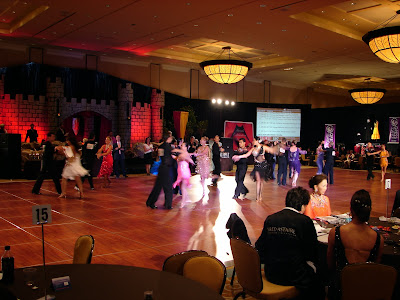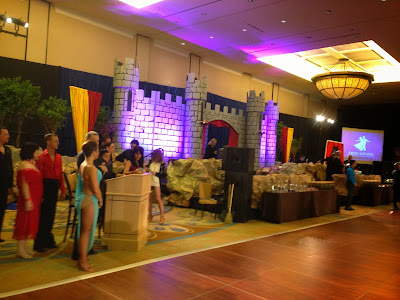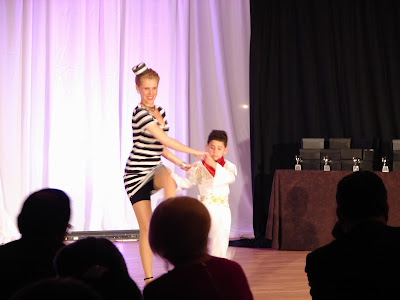FADS' Impact on Ballroom History
 |
| L to R: Martin Chiang, Jack Rothweiler and Wayne Eng, USDC 2013 |
|
Jack
Rothweiler was taken by surprise at USDC 2013 on Saturday evening, September 7, when USDC CEO and President, Martin Chiang
and Executive Vice President, Wayne Eng, called Jack to the stage to receive
the John Monte Award. This honor is one of two service awards USDC gives each year
to recognize one individual’s contributions to the dance world above all other
people in the business.
The John
Monte award is a tremendous honor in the field of dance, and its history
is tied closely to our company. Monte
himself died in 1990, so our details about him came through the memories of
someone in our business who actually worked with him: Richard LaValle. LaValle was a member of the original Fred
Astaire Dance Board, as well as a USBC Open American finalist with two dance partners
in the Monte years: Diana Montez
(1972-1974) and Linda (Douglas) Joy (1975-1976).
John Monte’s
life is woven into our history, as well as the history of the USDC. In fact, we can thank Monte for the original
United States Ballroom Championships, or USBC, which was eventually re-named
the USDC. USDC determines the United
States’ national Professional and Pro/Am Ballroom Dance Champions. Under
Monte’s leadership, the first USBC took place in 1971 and was held annually at
the Waldorf-Astoria Hotel in New York City through 1974.
That year, 1974,
also brought John Monte a monumental honor. The 1974 USDC program features a photo
of Princess Margaret presenting him the Carl-Alan Award, 'the only
American to receive this honor for his outstanding contribution to the popular
entertainment field in Great Britain.' That contribution was bringing ‘Touch Dancing’
back to ballroom at a time when dances like the Twist and the Mashed Potato
were keeping partners at arm’s length. *
Monte first
set foot in the dance business as a Fred Astaire student when he was about 16.
Like Astaire, Monte began as a tap dancer in an age when jazz and tap were
king. His FADS company career began in 1954,
about 7 years after Fred Astaire’s original dance classes began.
The Fred Astaire Main Office was located at 487 Park Avenue in New York City at the time. The company's
decision-makers gathered here to organize a 1958 ballroom convention at the
nearby unfinished Park East Studio. During that 2-week convention, about 150
Fred Astaire people from around the country packed the studio which had no proper floor. LaValle recalls seeing John Monte here for the first time. 'A little
guy on a raised platform with a piano,' the future Company leader sat square in
the middle of the ballroom. It was his job to provide the dancing music for the
convention!
In
approximately 1960, John Monte replaced Frank Pagliaro as FADS’ National Dance
Director. Monte became President of the National Council of Dance Teachers
Organization (NCDTO) in the United States (the NCDTO evolved into today’s NDCA). NCDTO work called for Monte and his
assistant, Dagmar Jarvel, to travel to Fred Astaire Dance Studios all over the
country to provide teacher competition training and dancing tests.
By 1969, there
were too many studio requests for Monte and Jarvel to manage by themselves. Monte came to a Chicago FADS convention and
announced he was putting together a company called “Dance Service Department”
to help. His idea was that Fred Astaire
people from the various areas would support FADS dance teachers’ training
sessions and promotions. Thus, the FADS Dance Board system was born! (Monte himself assigned LaValle the Midwest region.) The new regional format was highly successful
in meeting the studios’ needs.
Mary Molaghan
was the talented manager of the New England region. She and Monte formed a close
partnership, and in 1971, they founded the American Ballroom Company (ABC) whose
purpose was to establish U.S. ballroom champions, for there were none in those
days.
At that time,
the ABC was granted a charter from the NCDTO to run the official United States
Ballroom Championships (USBC), now known as the United States Dance
Championships (USDC), in all styles and divisions for Amateurs, Professionals, and
Pro/Am. The charter, revised in 1975, is the same today.
Monte and Molaghan
set about creating the USBC. LaValle remembers it was Molaghan who really 'put
the USBC together' when, in early 1971 at a Regional Competition he attended in
in New York, she entered a hotel room where Monte was holding a routine Dance
Service meeting. Mologhan made the
earth-shattering announcement that she and Monte were creating the first-ever U.S.
national competition. FADS had no
official U.S. dance representatives in the ballroom world. The format she
described would include an International Latin Style competition and an
International Ballroom Smooth (then called American Standard).
To everyone’s
further astonishment, Mary announced that this competition would recognize all
the top dancers in the United States, regardless of their company affiliation.
This meant including Murray and the independents, too! Furthermore, their competition would include a
Pro/Am division to recognize those who were tops in the U.S., as well as one
for top Amateur Couple. Other than the
winners of International Style, who would become U.S. Representatives to the
World Championships, all would be recognized U.S. Champions. Donna Smith, a FADS Dance Board Member who
was there, said, “Mary, it sounds wonderful, but it could be a conflict of
interest for us to promote this independent activity that is not just about
Fred Astaire. What’s in it for us?” Mary’s reply became her legacy: “Don’t worry kids, you’ll all get a piece of
the rock.”
The Area people
began promoting this new event, the USBC, in their travels. The first USBC was
held on Labor Day weekend, 1971, in the Waldorf-Astoria’s spectacular Grand
Ballroom. Richard LaValle was 31 at the time. Still, he can recall the names of
every Fred Astaire Dance Studios Champion in each division that weekend (and
all the way up to the present day, in fact!) “FADS,” he proudly recalls, “with the
exception of 1983 and 1984, held the American Championships from 1971 to 1990.”
John Monte also
served two 6-year terms as President of the NDCA (1975-80 & 1982-88). During
that time he was elected Vice President of the International Council of
Ballroom Dancers (ICBD). He was the first North American on the Presidium and
the Joint Committee (ICBD/ICAD).
We’re proud of
John Monte, which is why his name represents the second division of FADS’ SWAR
report. But we’re even more proud that independent companies like the USDC
recognize the important role he had in the history of ballroom dancing. Very few people have had the impact that John
Monte had on the ballroom dance world. Jack Rothweiler, though, is one of those few.
Martin Chiang
credits Jack Rothweiler with 'rescuing FADS from bankruptcy to become one of
the largest dance studios organizations and expanding overseas.' And though these accomplishments alone are
remarkable enough, we are thankful he has done so much more.
The John
Monte Award is reserved only for the greatest dance business leaders in the
world. Our heartfelt congratulations go
out to you, Jack Rothweiler. And thank
you so much.
Jack Rothweiler’s Contributions to the Fred
Astaire Franchised Dance Studios Organization
In 2002, Jack’s
first days as President were spent analyzing years of company statistics in order
to build our stronger future. The list
of his further accomplishments takes up two full pages, so we have only included some
highlights below.
Today, in
addition to his duties as President, Jack successfully oversees the largest
region in our franchise system, serves as Vice President on the WDC’s Board of
Directors (since 2008), and is an active registrant of the NDCA (since
2003).
Jack’s focus
has always been to make Fred Astaire Franchised Dance Studios the biggest and
best franchise operation in existence. The
entire company has grown and profited tremendously throughout the years of his
leadership. This profit has come in many forms, but it is our financial security,
collectively and individually, that Jack still works the hardest to secure. His ultimate aims are to give his employees —studio
owners, area people and office staff alike — every financial opportunity that
is available to them and to help them enjoy their working lives, as well as
their retirements. That explains why
Jack’s long-term goal as President has been to change the previous FADS mindset,
the one that said, “I am a dancer who happens
to own a studio” to “I am a successful business owner who also excels in
dancing.” Jack’s devotion to this proactive new mindset and the results it has
brought now offer every Fred Astaire family member unparalleled opportunities in
the world of dance.
Partial List of Jack's Achievements
·
Created the FADS Corporate Mission Statement
·
Increased and modernized our focus on education
through creating H.O.T, a library of business, motivational and marketing
materials, and studio staff training manuals.
·
Produced an entire system of manuals to help
structure our current franchise system and serve multiple training purposes.
·
Added trademarks and copyrights that have strengthened
our company and protect our trade name.
·
Created a Business Council to aid in developing
studios and enlarged the Board of Directors.
·
Re-designed and created new job positions to improve
oversight of key areas of the company.
·
Created the Checkouts database and the Astaire
Management Program, and upgraded SWAR’s functionality.
·
Developed data tracking systems to improve
studio’s abilities to better their numbers: Not Ups, ATD interviews, and KPIs,
for example.
·
Created our .info website to provide studio
owners with practically everything they need to run their businesses, from
archived TOP Seminar speeches to the newest studio products.
·
Developed the Studio Locator, an interactive map
on the national website that provides full contact information for every Fred
Astaire Dance Studio in the world.
·
Assisted in developing bigger and better FADS
Championships, as well as a greater FADS presence at U.S. National
Championships.
·
Created FADS logo products and logo-wear, and
produced our own shoe line to further brand our name and secure additional
revenue streams.
·
Developed a dress line for our newer competing
students to make their competition attire more affordable.
·
Secured advertising in national periodicals
(Dance Beat, Blackpool Project, and other regional publications).
·
Increased the number of our studios from 82 to
153 (as of this writing) and expanded Fred Astaire Dance Studios overseas. W now have a presence on 4 continents.
* Other Carl-Alan Award winners include the
Beatles, Nancy Sinatra, and Donnie Burns (now President of the WDC) with Gaynor
Fairweather (they won the award twice). Other
John Monte Award Winners Include: Judi
Hatton (2012); John Morton (2011); Frank Regan (2010); Rickey Geiger (2009);
Rufus Dustin (2008); Jim Donaghey (2007); Pete Taylor (2005); Betty Silvers
& Larry Silvers (posthumously, 2004); Brian McDonald (2003); Miranda Tang
(2002); Fran Rogers (2001); and Sam Sodano (2000).























